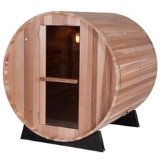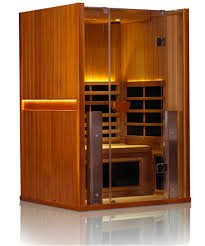Doing Yoga in a Sauna – A New Fitness Craze
Doing yoga in a sauna sounds crazy, but it’s a fitness craze that’s becoming increasingly popular with fans of yoga and sauna users alike.
Those who have tried are enthusiastic about how the combination of excessive sweating and movement of various muscle groups improve their overall health. Many people find that they also improve their deep breathing over time by practicing yoga while sweating away in a hot sauna.
In other words, combining the meditative flow of yoga with the intense heat of a sauna isn’t just a novelty — it’s an evolving wellness practice that’s finding its footing in both fitness studios and home saunas around the world.
Bikram Yoga vs. Hot Yoga
The practice of yoga in a sauna is a relatively new concept, first popularized by Yoga Master Bikram Choudhury in the 1970s. He developed twenty-six yoga postures and two distinct breathing exercises that were to be practiced during a ninety minute yoga session.
Bikram Yoga should be practiced in a 105° sauna with a humidity level of 40%.
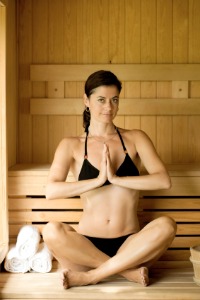
Only those yoga studios that have yoga instructors specifically trained and certified in Bikram Yoga can use the term Bikram.
There are many other yoga studios that feature Hot Yoga, which is very similar but may not use the same twenty-six poses. A more important distinction is the temperature – most Hot Yoga classes prefer a slightly lower temperature range of 95°-100°.
Advantages of Yoga Sessions in a Sauna
Beyond the trend factor, sauna yoga combines two powerful wellness tools — heat therapy and mindful movement — to amplify flexibility, focus, and recovery.
Enhanced Flexibility and Muscle Warmth
Heat loosens muscles and connective tissues, allowing for safer, deeper stretches. In a sauna, your body is already warm, which means less risk of pulling tight or “cold” muscles when moving through poses.
Lower Injury Risk
Warm tissues move better. Practicing yoga in a heated space may reduce the chance of muscle strain by increasing circulation and pliability. Still, gentle and mindful movement is key — not forcing poses just because the heat makes you feel looser.
Mental Focus and Breath Control
The combination of heat and movement demands concentration. Many find that sauna yoga heightens their awareness of breath and body, creating a deeper meditative experience. Breathing exercises (pranayama) in a sauna can enhance lung capacity and calm the nervous system.
Improved Circulation and Detox Support
The heat of the sauna dilates blood vessels, boosting blood flow to the muscles and skin. Combined with yoga’s movement, this enhances oxygen delivery and promotes a healthy sweat response. While sweating isn’t a full “detox,” it does help your body eliminate trace impurities and refresh the skin.
Muscle Recovery and Lactic Acid Reduction
Practicing yoga in a sauna environment may accelerate post-exercise recovery by improving circulation and reducing lactic acid buildup — especially after strength training or long runs.
What Kind of Sauna Works Best For Yoga?
Most practitioners find infrared saunas or hybrid setups ideal — warm enough to raise the heart rate and loosen muscles, but not so stifling that it overwhelms your breathing or concentration.
Although a traditional sauna has intense heat and gives you the authentic sauna experience, it's a bit too hot for long yoga sessions and challenging poses.
Infrared saunas offer gentle, tolerable heat and warm the body directly. The less steamy atmosphere makes breathing much easier.
A hybrid or low heat sauna gives you a nice balance between comfort and heat benefits, which is good for beginners or longer sessions.
Suggested Sauna Yoga Sequence
When practicing yoga in a sauna, the goal isn’t a fast-paced workout — it’s slow, deliberate, and mindful movement.
Warm-Up & Centering
Tadasana (Mountain Pose): Ground and align your posture.
Seated Pranayama: Deep breathing to adapt to the heat.
Cat–Cow (Marjaryasana–Bitilasana): Loosen the spine.
Gentle Flow
Seated or Standing Forward Fold: Lengthen hamstrings and release tension.
Low Lunge (Anjaneyasana): Open up hip flexors.
Bridge Pose (Setu Bandha Sarvangasana): Engage the glutes and open the chest.
Cool Down & Recovery
Reclining Twist: Gentle spinal release.
Savasana (Corpse Pose): Rest and absorb the heat’s calming effects.
Tips
- Start with 10–15 minutes total time.
- Choose wide, stable poses — avoid deep balancing or inversions in extreme heat.
- Listen to your body: if you feel dizzy or fatigued, step out and cool down.
Precautions
Because it is an intense workout in a relatively extreme environment, doing yoga while in a heated sauna should only be practiced by individuals who have already been doing yoga for a while or who are used to the higher temperatures of a sauna.
Make sure you start cool: begin at lower heat and build up gradually.
Know the warning signs. Some people can become dizzy, light-headed or nauseous when practicing yoga in the heat of a sauna. You may experience a rapid heartbeat or blurred vision. If you experience any of these symptoms, you should immediately stop your workout and go to someplace where you can cool down.
Avoid overstretching if you can; heat can create a false sense of flexibility.
It’s also crucial to stay hydrated before and after Hot Yoga or Bikram Yoga. Be sure to drink plenty of water, but don’t eat for at least two hours before your yoga session in the sauna. Replace lost electrolytes (not just water) after sessions.
This will prevent nausea and sluggishness. If you haven’t practiced yoga in a sauna before, talk to your doctor to make sure it is safe.
Final Thoughts
Yoga in a sauna represents a unique meeting point between mindfulness and endurance — where you can stretch deeper, sweat harder, and quiet the mind all at once. Done thoughtfully, it can enhance flexibility, recovery, and relaxation.
But as with any intense wellness practice, respect your body’s limits. Hydrate, rest, and ease into it slowly. With practice, you’ll discover that sauna yoga isn’t about pushing through the heat — it’s about finding stillness and strength within it.
Infrared Saunas
Sauna Heaters
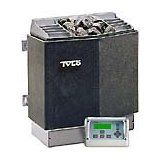
How to Install a Wood Sauna Heater
Sauna Kits
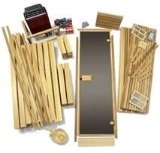
Buying Guide
